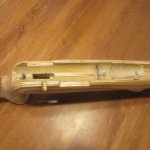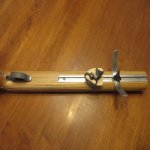Some good suggestions above.
Background... I used to use industrial epoxies to repair wooden racing shells - at one point we had three 20 L cans of "sun cure" epoxy (discontinued, I think) that was a 2:1 resin:hardener mix by volume.
Now, when I'm doing anything like the OP is proposing (laminating wood, building up a sheet of carbon fibre for a repair, fixing dissimilar products together, for example)., I use West System with the slow hardener. I only do "wet layup" stuff. A friend does vacuum bagging when he fixes honeycomb and carbon fibre boats - he uses West System as well. but that vacuum bagging is a special skill.
A few suggestions about this type of epoxy:
You can't leave it "in the pot" while you tinker and set stuff up - you have to get it spread out quickly - stir it for a minute or two, let it sit for a couple of minutes, and then get it spread out - epoxies are exothermic (they warm up while they cure) and if you leave them in the pot, they can surprise you how quickly they "go off", and how hot they get (voice of experience).
Once it's in a thin layer, like brushed onto the bits of wood you're laminating together, you have more time because it's too thin a layer to generate heat faster than the heat goes out into the environment.
Some glues you want to have high clamping pressure, epoxies not so much.
Wear strong nitrile gloves when working with epoxy - any epoxy - the hardeners can soak into your skin and "sensitize" you - essentially making you allergic. If you're using lots of the stuff, a chemical filter mask wouldn't hurt either - work in a well-ventilated area. If you do get epoxy on your skin, use a waterless hand cleaner and get it off, as soon as you can, and then wash. When I'm doing a bigger job with a risk of ripping a glove, I double up and wear two nitrile gloves on each hand.
Epoxies work differently from "fibreglassing" resins in that the hardener-resin mix ratio has to be pretty accurate, because the hardening is done by the molecules of hardener shaking hands with the molecules of resin - whereas "fibreglassing" resins (and things like bondo) are "catalyzed" where more catalyst makes the cure go faster. Putting too much or not enough hardener with the resin will just give a messy, improper cure. (West System is a 5:1 by volume epoxy, and the company sells pump kits that go with the resin-hardener tins - one pump each makes about an ounce (about 30 ml) of mixed epoxy.
For this sort of job, patience is a virtue - slow-curing (24 hours, for example) epoxies give you better "working time" after you stir the stuff, and are less permeable to water, but they're still exothermic and you can't dawdle. 5-minute epoxies absorb water and swell over time. Unlike a lot of wood glues, epoxies don't "dry," they "cure" - they won't skin-over while you're working with them exposed to air.
After the epoxy has cured, sanding and "working" with cured epoxy can still "off-gas" for a while after it's set - how long that while is depends on the epoxy and should be outlined in the material safety sheets.
It might be a good idea to use some cheapo wood with ordinary glues to practice the layup/wetting and clamping before you go with epoxy - it's expensive (the good stuff is, anyway)
If you're going with a laminating epoxy, RTFM (Read The .... Manual) There are all kinds of precautions and suggestions about how to work with the epoxy in the literature you get when you buy the stuff. I've only scratched the surface.
Background... I used to use industrial epoxies to repair wooden racing shells - at one point we had three 20 L cans of "sun cure" epoxy (discontinued, I think) that was a 2:1 resin:hardener mix by volume.
Now, when I'm doing anything like the OP is proposing (laminating wood, building up a sheet of carbon fibre for a repair, fixing dissimilar products together, for example)., I use West System with the slow hardener. I only do "wet layup" stuff. A friend does vacuum bagging when he fixes honeycomb and carbon fibre boats - he uses West System as well. but that vacuum bagging is a special skill.
A few suggestions about this type of epoxy:
You can't leave it "in the pot" while you tinker and set stuff up - you have to get it spread out quickly - stir it for a minute or two, let it sit for a couple of minutes, and then get it spread out - epoxies are exothermic (they warm up while they cure) and if you leave them in the pot, they can surprise you how quickly they "go off", and how hot they get (voice of experience).
Once it's in a thin layer, like brushed onto the bits of wood you're laminating together, you have more time because it's too thin a layer to generate heat faster than the heat goes out into the environment.
Some glues you want to have high clamping pressure, epoxies not so much.
Wear strong nitrile gloves when working with epoxy - any epoxy - the hardeners can soak into your skin and "sensitize" you - essentially making you allergic. If you're using lots of the stuff, a chemical filter mask wouldn't hurt either - work in a well-ventilated area. If you do get epoxy on your skin, use a waterless hand cleaner and get it off, as soon as you can, and then wash. When I'm doing a bigger job with a risk of ripping a glove, I double up and wear two nitrile gloves on each hand.
Epoxies work differently from "fibreglassing" resins in that the hardener-resin mix ratio has to be pretty accurate, because the hardening is done by the molecules of hardener shaking hands with the molecules of resin - whereas "fibreglassing" resins (and things like bondo) are "catalyzed" where more catalyst makes the cure go faster. Putting too much or not enough hardener with the resin will just give a messy, improper cure. (West System is a 5:1 by volume epoxy, and the company sells pump kits that go with the resin-hardener tins - one pump each makes about an ounce (about 30 ml) of mixed epoxy.
For this sort of job, patience is a virtue - slow-curing (24 hours, for example) epoxies give you better "working time" after you stir the stuff, and are less permeable to water, but they're still exothermic and you can't dawdle. 5-minute epoxies absorb water and swell over time. Unlike a lot of wood glues, epoxies don't "dry," they "cure" - they won't skin-over while you're working with them exposed to air.
After the epoxy has cured, sanding and "working" with cured epoxy can still "off-gas" for a while after it's set - how long that while is depends on the epoxy and should be outlined in the material safety sheets.
It might be a good idea to use some cheapo wood with ordinary glues to practice the layup/wetting and clamping before you go with epoxy - it's expensive (the good stuff is, anyway)
If you're going with a laminating epoxy, RTFM (Read The .... Manual) There are all kinds of precautions and suggestions about how to work with the epoxy in the literature you get when you buy the stuff. I've only scratched the surface.















































































